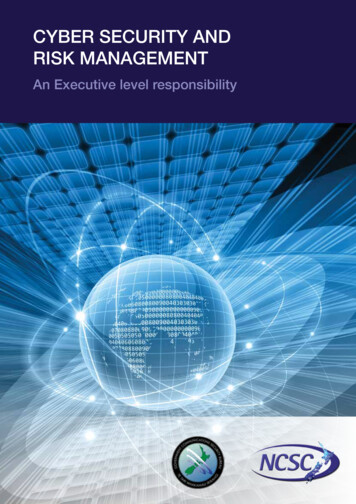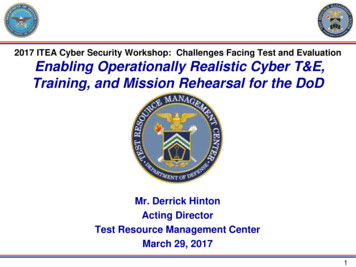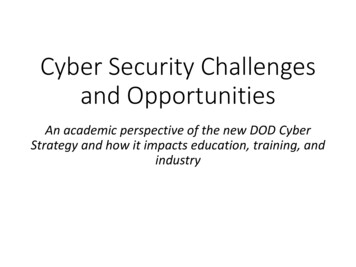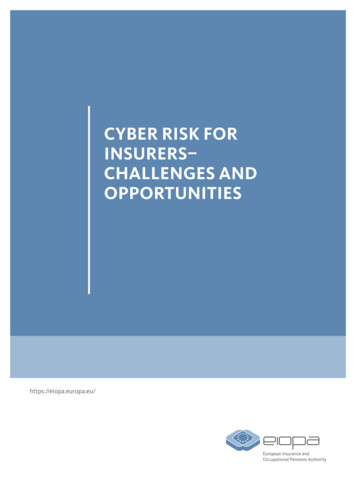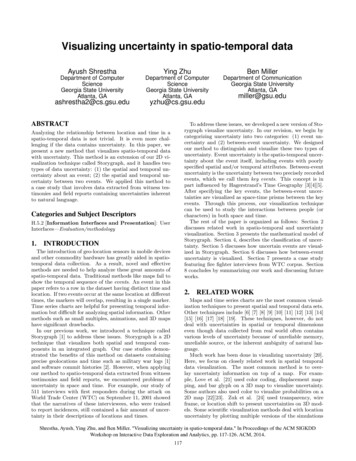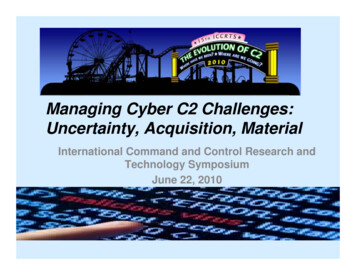
Transcription
Managing Cyber C2 Challenges:Uncertainty, Acquisition, MaterialInternational Command and Control Research andTechnology SymposiumJune 22, 2010
Panel ParticipantsDr. Isaac Porche, Senior Engineer, RANDRichard Mesic, Senior Policy Analyst, RANDDr. Elliot Axelband, Senior Engineer, RAND
Cyberspace Facilitates Command and ControlAcross the Traditional itimedomainChallenges:Enabling properties: Constantly growing in size andcomplexityMan-madeUncertainty abounds about terms and roles, and about actors, e.g., anonymity. Access to information,Situational awarenessSynchronized operations,
Numerous Threats Exist but theSource/Agents Can Be Difficult to Identify External threatsInternal Errors– Operators slow torecognize threats– Operators mistakeproblems for normalsystem activity– Security specialists failto realize andcommunicate how large aproblem may beThese challenges place a premium on effective defense.
To Manage These Challenges, We Needto Consider: What kinds of operational certainties anduncertainties effect cyberwarfare andsecurity What software, IT, and hardware is neededand can be acquired to secure cyberoperations The trade-off between security andinformation sharing
To Manage These Challenges, We Needto Consider: What kinds of operational certainties anduncertainties effect cyberwarfare andsecurity (Richard Mesic) What software, IT, and hardware is neededand can be acquired to secure cyber operations The trade-off between security andinformation sharing
Can We Effectively and Efficiently Command andControl Systems that Are So Broad, HighlyClassified, and Poorly Understood?IO CNO EWO IWOCNO CNE CND CNAMost CNO capabilities fall into the “poorly understood” category
Maybe the Most Understandable CyberEffects Are “Soft” (e.g., directed PSYOP)The COCOM’s priority is to assurethat PSYOP messages and deliverymeans are coordinated and deconflicted with other kinetic andnon-kinetic operations.
Coordinating and De-ConflictingOffensive Cyber and Non-Cyber Missionsand Systems Is a C2 Challenge This is due partly to the lack of cyber experience andthe lack of a non-kinetic “JMEM” The challenge is particularly severe with respect toestimating and controlling cyber collateral damage Integrating kinetic and non-kinetic (eg., cyber)capabilities is a C2 challenge that seems to defaultto a C2 focus on kinetic missions and systems withnon-kinetic capabilities in a supporting (bonus) role
Cyber Blurs Distinctions BetweenCombatants and Non-Combatants The extension of the LOACto cyberspace is still a workin progress. For now, the cybercommander’s constantcompanion is likely to be aJAG.
Because of Legal and Operational Uncertainties,Significant Cyber Action Is Often Approved Onlyat the Highest Levels of CommandCyberIncident orOpportunityResponse to Incident or OpportunitySECDEF orPresidentBecause of planning, coordination and approval timelines, lower-level commanders may be reluctant toincorporate significant cyber capabilities at theoperational/tactical levels of warfare.
Cyber’s Greatest Potential May Be inIrregular Warfare Missions and Day-to-DayIntelligence Operations and Environment-ShapingThat May Require The Military to play merely a supporting role to othergovernment entities Cyber C2 to become a matter of inter-agencycooperation, with all the associated cultural andprocedural difficulties The DoD and COCOMS to be seldom given unilateralcyber C2 responsibilities and authority.
Cyber Operational Preparation of theEnvironment Operates in the Seams of Title10/50 Responsibilities and AuthoritiesC2 is a sharedactivity between thecommander’sintelligence andoperations entitiesas well asorganizationsbeyond thecommanderscontrol (e.g. NSA).
The Execution of Cyber Tools andSystems Requires STRATCOM/USCYBERCOMRegional COCOMsIntelligence:NSACIAService Intelligence OrganizationsOther (e.g., DHS, FBI, )Service ComponentsSTO Cells . . .This can present significant unsolved C2 challenges.
C2 Cyber Is Hindered by a Lack of CyberSituational AwarenessCyber capabilities and threat, friendly, or otherstatus are difficult to:defineassessvisualize
Responsibility and Authority PoseSignificant Challenges to Cyber C2 Who owns and controls what in a landscapeof dispersed “net-centric” ownership? Commercial systems and providers (US andother) Service-specific systems Allies . . . How will actions - even purely defensiveones - in one area of cyber space effectothers?
To Manage These Challenges, We Needto Consider: What kinds of operational certainties anduncertainties effect cyberwarfare and security What software, IT, and hardware is needed andcan be acquired to secure cyber operations(Elliot Axelband) The trade-off between security and informationsharing
What Is to Be Acquired in Order to PerformOptimally in the Cyber-Landscape? Software? IT? Hardware? Cyber/EW?
It Depends on What Is the EnvisionedLife-Cycle?, AF Tentative Plans Real Time - Hrs/Weeks– Software/ITRapid - Weeks Months– Software/IT– COTS/GOTS, ModsEnduring - Years– PEOs/PMs– JCIDS/5000 Process– SW/IT/HWWork at the shop or floor level withwith industry poised to react“Big Safari”- likeA new AFMC Cyber SafariExpedite using existingContract Vehicles“ We believe that existing DoD series and FARS provide you most to the flexibility youneed.”.“ I don’t think there needs to be any change in acquisition laws or rules”“ It may require a change in the way our contracting officers look at the existing rules.”General Lord as quoted in Inside the Air Force, 091218.
How Does Acquisition Fit in With CurrentUS DoD Policies? USSOCOM EnablersUS Army - ONS;US Navy - UON;US Marines; UUNS,US Air Force - CCD,US DoD - JUONS
What Is Everyone Saying About CyberAcquisition? - DSB and others DSB, 3/09 Task Force– Focus - Business Systems, Information Infrastructure, C2,ISR, Embedded IT in Weapon Systems, and IT upgrades tofielded systems– JCIDS conventional process too cumbersome - retain forefforts with significant scientific, engineering, hardwaredevelopment and the integration of complex systems only– New Acquisition Policy for IT needed, and workforce trainedfor it– Acquisition Policy Recommended that produces firstincrement of capability in 3 1/2 years and subsequentincrements in 18 months or less– USD (AT&L) with VCS should lead this effort with supportfrom CIO, PA&E, DDR&E, OT&E, Controller, Users andothers
What Is Everyone Saying About CyberAcquisition? - NRC - 2010 Focus - Software in COTs Computers not embedded in WeaponSystemsConclusions DoD IT Acquisition too lengthy vs. Commercial Systemsdeveloped using Agile Methods– Less Oversight, Less Paper, Less Process Focus, More ProductFocus– Develop Pieces– Test Frequently with Users– Aggregate pieces to get not all of the capabilities you require butbetter customer satisfactionPresenters Comments– Generally speaking we are talking about more than COTScomputers not embedded in Weapon Systems– Agile methods are experimental– This approach would require heavy experimentation/prototyping
What Is Everyone Saying About CyberAcquisition? - Congress WSARA - 2009– Establishes new organizations and their roles and responsibilities, and modifies thoseof existing organizations– Complicates DoD acquisition for major weapon systems, its focus so as to improve itsoperation - On time delivery within budget of acquired products and services thatprovide their intended capabilities– DoD implementation complicates JCIDSHASC Panel on Acquisition Reform, March - 2009– Directs the implementation of an alternate process for IT AcquisitionIMPROVE - April 2010– Expands WSARA to all of acquisition, but does not discuss urgent acquisitions– Adds complications such as requirement for tracking performance using new metrics,and expanding the charters of the WSARA organizations– Requires changes to JCIDS to make it more rigorous and less cumbersome– Charters GAO to report on applicability of changes made to JROC to otheracquisitions including information technology– Certification and training required required for acquisition personnel with emphasison the acquisition of services, information technology, and rapid acquisitions.
Convergence of Traditionally DistinctAreas Wired andWirelessCyber andElectronics
To Manage These Challenges, We Needto Consider: What kinds of operational certainties anduncertainties effect cyberwarfare andsecurity What software, IT, and hardware is neededand can be acquired to secure cyberoperations The trade-off between security andinformation sharing (Isaac Porche)
Today, There Exists Inherent Trade-offs BetweenSharing Information and Protecting/Assuring It
There Are Multiple Reasons for theTrade-Offs Culture: CISO vs. CIO mindset In wireless medium, disbenefits to ubiquitous connectivitypersist (Joe and Porche, 2004)e.g., throughput penalty Ubiquitous or increased connectivity adds to complexity, and“Complexity is the worst enemy of security”From: Schneier, Secrets and Lies, 2000, P.354 Access to information is equated to access to the network(9/11 Commission report, p 418, Markel Report)This does NOT have to be the case
Cultural/Operational Preferences:“Keep the Net Up”HighConnectivityLowSecurityToday’s Operational Goals CIO focus Security CISO focus Connectivity
Connectivity Challenges for OTM: WirelessNetworks Don’t Scale WellThe Penalty is ThroughputRef: Joe and Porche, 2004
sharedMeaningfully Increased ConnectivityRequires InteroperabilityInteroperabilityAdds toComplexityInteroperability is Lacking at Many Layers/Levels
Lack of Interoperability is a Security FeatureOpen Question:What happens when/ifinteroperability is fixed beforewe can protect our networksand repositories fromcompromise ?
shad aredve wrsa ithryLack of Interoperability is a Security Feature(cont.)Possible Answer:We could lose more“High value”knowledge (instead oflower valued info anddata).
COTS Applications are Sources ofVulnerabilityThis is whyCOTS reliance istroubling Companies treat security as a“penetrate and patch” activity done afterthe application is deployed. Application security flaws are generallyintroduced early in the design cycle. Typical COTS applications may be “atserious risk.”*Source: Jaquith, Andrew, Security Metrics: Replacing Fear,Uncertainty, and Doubt, 2002.Results from a 2001 survey from a commercial security consultant
Application Complexity is a ParticularCulpritThe Crescent ofVulnerabilitySystem functionalityAnticipated &Modeled functionalityService Oriented Architectures (SOA) promise unanticipated functionality –which the commercial world has found to be a source of vulnerability
The “Farewell Dossier” Example: A Reminderon the Threat from Malicious Code* Trojan horse was inserted into Canadian softwaredesigned for control of natural gas pipelines Software was “allowed” to bestolen and used by the Sovietswith explosive resultsSource: .htmReed, Thomas, At the Abyss: An Insider’s History of the Cold War, Random House, 2004
Access to Information is Equated to Accessto the NetworkToday’s [USG] information systems are air-gapped– Quoting: “Many critical [USG] information repositoriesare not compatible with the analytic tools, and manystill are air-gapped and not accessible online toanalysts.” (Markel Report, P. 22)
Fixing the Trade-off May Involve.1.New systems that control access to the data, not access to thewhole network (9/11 Commission report, p 418) “Transactional access control” techniques e.g., RAdAC2.Philosophical shift from “need to share” vs. “need to know” Includes revisiting what information has to be secured3. Quantitative/Analytic network design tools that can model both userbehaviors and network performance4. Robust IA and CND
Are We Headed Down This ss?
Questions and Comments
References Aviation Week, 100329 and 100524DSB, Task Force on the Acquisition of Information Technology, 3/09F-18 G Picture, s/military/ea18g/C22-658-19.htmlIttig, Kristen, Ronald A. Schecter, and Suzanne Sivertsen, “House Armed Services CommitteeUnanimously Approves Defense Acquisition Reform”, April 2010, Arnold and Porter, LLP, AdvisoryGiffin, R. E., and D. J. Reid, “A Woven Web of Guesses, Canto One: Network Centric Warfare and theMyth of the New Economy,” 8th International Command and Control Research Symposium, Washington,D.C., C4ISR Cooperative, Research Program (CCRP), 2003.Gilder, George, “Metcalfe’s Law and Legacy,” Forbes ASAP, September 13, 1993.Government Accountability Office (GAO), Recent Campaigns Benefited from Improved Communicationsand Technology, but Barriers to Continued Progress Remain, GAO-04-547, June 2004.HASC Panel on Acquisition Reform, March - 2009JCIDS Summary View, DAU Repository, https-//acc.dau.mil/ as of 100512Joe, Leland and Isaac Porche, Future Army Bandwidth Needs and Capabilities, Santa Monica, Calif.:RAND Corporation, MG-156-A, 2004, available htmlInside the Air Force, 12/18/2009, “AFMC Building an Acquisition Plan for Cyber Purchases”Markle Foundation, Creating a Trusted Network for Homeland Security, New York, 2003. As of October25, 2007: http://www.markle.org/downloadable assets/nstf report2 full report.pdfNational Commission on Terrorist Attacks upon the United States, The 9/11 Commission Report: FinalReport of the National Commission on Terrorist Attacks upon the United States, Washington, D.C.: U.S.Government Printing Office, 2004. As of December 26, 2007: http://www.gpoaccess.gov/911/NRC, Report re Achieving Effective Acquisition of DoD IT, 2010Porche, Isaac, and Bradley Wilson, The Impact of the Network on Warfighter Effectiveness, SantaMonica, Calif.: RAND Corporation, TR-329-A, 2006, available atwww.rand.org/pubs/technical reports/TR329/RAND Arroyo Center, A Campaign Quality Army: Annual Report 2005, available atwww.rand.org/pubs/annual reports/2006/RAND AR7110.pdfTolk, Andreas, “Beyond Technical Interoperability: Introducing a Reference Model for Measures of Merit
This is due partly to the lack of cyber experience and the lack of a non-kinetic "JMEM" The challenge is particularly severe with respect to estimating and controlling cyber collateral damage Integrating kinetic and non-kinetic (eg., cyber) capabilities is a C2 challenge that seems to default to a C2 focus on kinetic missions and .


